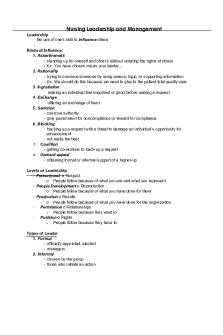Leadership and Management Models PDF

| Title | Leadership and Management Models |
|---|---|
| Author | Shertonia Stanley |
| Course | Servant Leadership |
| Institution | Grand Canyon University |
| Pages | 4 |
| File Size | 103 KB |
| File Type | |
| Total Downloads | 43 |
| Total Views | 147 |
Summary
Graphic of your model with the written analysis that represent your understanding of servant leadership or revise one of the existing graphics so that it better represents your understanding....
Description
Shertonia Stanley October 10, 2020 Scott Ross MGT-410-O501 The unique characteristics of servant leadership are empathy the understanding other's feelings, needs, desires etc. Self-awareness It helps in gaining confidence and focus on selfassessment. Persuasion influences the opinions and actions of others through their persuasive skills. Conceptualization imagines the possibilities of future and reconcile it with current realities. Healing focuses on the emotional and spiritual well-being of the followers. Stewardship takes complete responsibility for planning and managing all available resources for the betterment and growth of the organization, employees, and stakeholders. Foresight has the intuitive ability to predict the future, based on the past and the present. Listening pays complete attention to the followers to understand all interpersonal situations, resolve conflicts, counsel other, etc. Commitment to the growth of people an intrinsic value beyond their tangible contributions as workers. Building community, the servant-leader senses that much has been lost in recent human history as a result of the shift from local communities to large institutions as the primary shaper of human lives Dierendonck & Patterson (2010). These elements are different from others leadership because Servant leaders focus is the well-being of the followers whereas traditional leaders focus is the growth and development of the company. Servant leader focus on other interest and they don't change their behavior as per the situation. Traditional leaders can be adjusted as per the behavior and skill level of the employees. Servant leadership style make the employees happy and more engaged in work. Traditional leaders focus on organizational profits and growth. The paradox of servant leadership is the two words put together: servant and leadership. How can one serve and be a leader at the same time? In the following model you see the paradox in recognizing that an effective servant leader requires more than just a desire to serve. He/she must have certain characteristics and qualities in order to enhance the desire to serve into a leadership position. In other words, in order to create an environment where others are truly served, the servant leader must develop themselves to serve in the most effective way. The graphic demonstrates that although a servant leader must start with a desire to serve, it does not end there. Servant leadership can be effectively understood with the graphic representation given parameters by listing in order from the top then clockwise my understanding of effective leadership characteristics. Starting with self-development it should be continual through training of skill enhancement and development of capabilities to perform better. Which leads to team development abilities, the able to understand the meaning and relevance of cooperation and collaboration amongst one another. Then ethical practice and civic mindedness simply means doing good for others and performing the best where people can recognize the good
elements you are providing to the employees. These characteristics cannot be achieved without strategic thinking. You must think through the perspective of various elements, what employees want, what an organization can give and how all this would then be managed for long term benefits and growth. The organization growth comes from innovation this increases chances to discover new opportunities and help foster a competitive advantage by allowing you to build better products and services.
References: Dierendonck, D., & Patterson, K. (2010). Servant leadership: Developments in theory and research. New York, NY: St. Martin's Press LLC. ISBN-13: 9780230238268...
Similar Free PDFs

Leadership and Management Models
- 4 Pages

Nursing Leadership and Management
- 23 Pages

HRM Models in leadership
- 9 Pages

Chapter 7 Management and Leadership
- 29 Pages

Leadership& Management
- 5 Pages

Leadership & Management
- 77 Pages

Management & leadership
- 9 Pages

Leadership vs Management Essay
- 3 Pages

Client Management Leadership Report
- 12 Pages
Popular Institutions
- Tinajero National High School - Annex
- Politeknik Caltex Riau
- Yokohama City University
- SGT University
- University of Al-Qadisiyah
- Divine Word College of Vigan
- Techniek College Rotterdam
- Universidade de Santiago
- Universiti Teknologi MARA Cawangan Johor Kampus Pasir Gudang
- Poltekkes Kemenkes Yogyakarta
- Baguio City National High School
- Colegio san marcos
- preparatoria uno
- Centro de Bachillerato Tecnológico Industrial y de Servicios No. 107
- Dalian Maritime University
- Quang Trung Secondary School
- Colegio Tecnológico en Informática
- Corporación Regional de Educación Superior
- Grupo CEDVA
- Dar Al Uloom University
- Centro de Estudios Preuniversitarios de la Universidad Nacional de Ingeniería
- 上智大学
- Aakash International School, Nuna Majara
- San Felipe Neri Catholic School
- Kang Chiao International School - New Taipei City
- Misamis Occidental National High School
- Institución Educativa Escuela Normal Juan Ladrilleros
- Kolehiyo ng Pantukan
- Batanes State College
- Instituto Continental
- Sekolah Menengah Kejuruan Kesehatan Kaltara (Tarakan)
- Colegio de La Inmaculada Concepcion - Cebu






